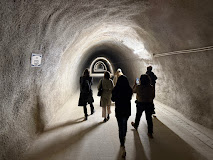
©
У рамках міської садово-культурної ініціативи у столиці Люксембургу відкрили для публіки незвичну виставку — звукову інсталяцію у підземному Акватунелі, побудованому ще у 1960-х роках для відведення стічних вод із південної частини міста. Понад півстоліття тунель залишався закритим для громадськості. Авторкою звукової інсталяції стала всесвітньо відома шотландська художниця Сьюзан Філіпсз, яка працює з просторовим звучанням. Цей проект — її перша робота у тунельному середовищі. «Тут виняткова акустика. Звуки, голоси, відлуння – усе грає по-іншому, і саме це надихнуло художницю», — розповіла директорка Музею MUDAM Беттіна Штайнбрюгге. Звукове оформлення базується на вокальному колажі, який поєднує голос самої художниці з елементами сучасної інтерпретації співів сирен. Мисткиня звертається як до античної грецької міфології, так і до місцевих легенд, зокрема образу Мелюзіни, фольклорної істоти, пов’язаної з історією Люксембургу. Простір довжиною 900 метрів та висотою 3,25 метра веде під центром міста. Для орієнтації встановлені покажчики із назвами вулиць, що проходять над тунелем. Візит триває близько 20–30 хвилин. Задля безпеки кількість учасників обмежена (до 30 осіб на сеанс), а перед входом проводиться інструктаж — зв’язку під землею немає, а вентиляція — обмежена. Акватунель був збудований у 1961–1963 роках як інженерне рішення у відповідь на зростаючі потреби району Мерль, де розташувалася молочарня Luxlait. Проект також мав подвійну мету — у період Холодної війни він міг слугувати бомбосховищем. Виставку можна відвідати до жовтня 2025 року.
In Luxembourg, a Former Sewage Artery Transformed into an Art Space
As part of a citywide garden and cultural initiative, an unusual exhibition has opened to the public in Luxembourg’s capital — a sound installation set inside the underground Aquatunnel, originally built in the 1960s to carry wastewater from the southern part of the city. For over half a century, the tunnel remained closed to the public. The installation was created by internationally acclaimed Scottish artist Susan Philipsz, known for her work with spatial sound. This project marks her first artistic intervention in a tunnel environment. “The acoustics here are extraordinary. Sounds, voices, echoes — everything behaves differently underground, and that’s what inspired the artist,” explained Bettina Steinbrügge, director of Luxembourg’s MUDAM museum. The soundscape is built around a vocal collage, blending the artist’s own voice with elements of contemporary interpretations of siren songs. Philipsz draws on both ancient Greek mythology and local Luxembourgish legends, in particular the figure of Melusina, a folkloric creature closely tied to the city’s history. The 900-meter-long and 3.25-meter-high tunnel runs beneath central Luxembourg. For orientation, signs bearing the names of the streets above have been installed along the route. The visit lasts about 20 to 30 minutes, and group sizes are strictly limited to 30 people per session for safety reasons. Prior to entry, visitors receive a briefing — there is no mobile signal underground and limited ventilation. The Aquatunnel was constructed between 1961 and 1963 as a technical response to the growing demands of the Merl district, which at the time was home to the Luxlait dairy plant. The project was also designed with a dual purpose: during the Cold War, it could serve as a bomb shelter in the event of an attack. The exhibition is open to the public until October 2025.
1477